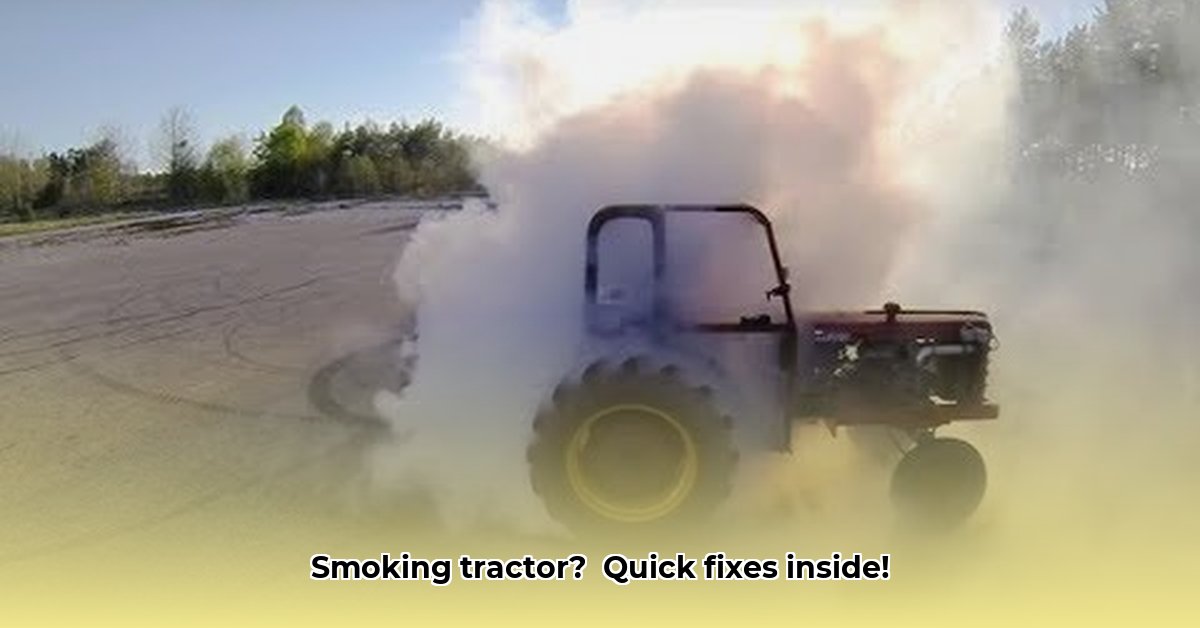
Decoding the Smoke Signals: Understanding Your Tractor's Warning Signs
Seeing smoke billowing from your tractor's exhaust is concerning, but understanding the type of smoke provides crucial diagnostic information. Different colors indicate different underlying problems. Let's break it down:
Blue Smoke: This usually indicates burning engine oil, suggesting worn piston rings, valve seals, or valve guides. (Worn parts allowing oil to enter the combustion chamber.) This is a moderate to high severity issue.
White Smoke: White smoke often points to coolant mixing with the combustion process. This is a serious issue, potentially indicating a cracked cylinder head, blown head gasket, or a leak in the cooling system. (Coolant entering the cylinders.) Immediate attention is needed. This is a high-severity issue.
Black Smoke: Black smoke usually points to a rich fuel mixture – your engine is getting too much fuel and not enough air. (Excess fuel being burned incompletely.) This often indicates a clogged air filter or a problem with the fuel delivery system. This is a moderate severity issue.
Gray/White Smoke (Light): This can often be caused by condensation, particularly in humid conditions, especially after a cold start. This is usually not a cause for concern. (Water vapor expelled from the exhaust.) This is a low-severity issue.
For more detailed troubleshooting, check out this helpful resource on Ford 4610 tractor problems.
Troubleshooting Your Smoky Tractor: A Step-by-Step Guide
Before you begin, remember safety first! Always allow the engine to cool completely before performing any maintenance or repairs. Wear appropriate safety gear, including gloves and eye protection.
Step 1: The Visual Inspection (Safety First!)
Begin with a thorough visual inspection of the tractor's engine and surrounding components. Look for any obvious signs of leaks, such as:
- Oil Leaks: Check for oil stains or drips around the engine, oil pan, and valve covers.
- Coolant Leaks: Look for coolant stains or drips around the radiator, hoses, water pump, and cylinder head.
- Exhaust Leaks: Inspect the exhaust system for cracks or damage.
Step 2: Fluid Level Checks
Check the levels of engine oil, coolant, and fuel. Low levels can indicate leaks, which need immediate attention. Also, examine the condition of the fluids themselves. Milky engine oil strongly suggests coolant is entering the oil system (head gasket failure being a prime suspect), and this needs prompt professional attention.
Step 3: The Compression Test
A compression test is a critical diagnostic step for detecting internal engine problems. This test measures the pressure within each cylinder. Low compression in one or more cylinders usually indicates worn piston rings, damaged valves, or a blown head gasket, (internal engine components not sealing properly). A mechanic's compression tester is required for this test.
Step 4: Air Filter Assessment
Inspect the air filter for cleanliness and proper functioning. A heavily clogged air filter restricts airflow to the engine, leading to a rich fuel mixture and black smoke. Cleaning or replacing is a simple fix if this is the problem.
Common Smoking Tractor Problems and Solutions
The following table summarizes common causes of smoking tractors and their corresponding solutions.
| Smoke Color | Likely Cause | Possible Solutions | Severity |
|---|---|---|---|
| Blue | Burning engine oil (worn piston rings, seals, valve guides) | Oil change, engine repair (potentially ring or seal replacement). | Moderate to High |
| White | Burning coolant (head gasket failure, cracked cylinder head, coolant leak) | Head gasket replacement, cylinder head repair or replacement, cooling system leak repair. | High |
| Black | Rich fuel mixture (clogged air filter, fuel delivery issues) | Clean or replace the air filter, check fuel injectors and delivery system. | Moderate |
| White/Gray | Condensation (especially in humid conditions) | Usually not a problem; monitor for more concerning symptoms over time. | Low |
Preventative Maintenance: Keeping Your Tractor Running Smoothly
Regular maintenance is essential for preventing problems. Consider this a proactive approach!
- Regular Oil Changes: Follow the manufacturer's recommended oil change intervals and use the correct type and grade of oil.
- Air Filter Maintenance: Regularly inspect and clean or replace the air filter.
- Cooling System Checks: Regularly inspect your cooling system for leaks, proper coolant levels, and the condition of hoses.
- Belt and Hose Inspections: Periodically inspect all belts and hoses for wear and tear. Replace damaged components promptly.
- Scheduled Compression Tests: Have a compression test performed annually to proactively detect problems before they become major issues.
Expert Insight: Addressing Complex Issues
"Ignoring a smoking tractor can lead to catastrophic engine damage," states Dr. Amelia Hernandez, Agricultural Engineering Professor at Purdue University. "Regular maintenance and prompt attention to any unusual symptoms are crucial in preventing costly repairs."
Remember, if you're unsure about any aspect of diagnosing or repairing your smoking tractor, consult a qualified mechanic. They have the expertise and tools to accurately diagnose and fix the problem effectively.